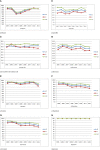Escherichia coli Isolated from Urinary Tract Infections of Lebanese Patients between 2005 and 2012: Epidemiology and Profiles of Resistance
- PMID: 25984513
- PMCID: PMC4415468
- DOI: 10.3389/fmed.2015.00026
Escherichia coli Isolated from Urinary Tract Infections of Lebanese Patients between 2005 and 2012: Epidemiology and Profiles of Resistance
Abstract
The early treatment of urinary tract infections (UTIs) is directly related to decrease in morbidity, which makes the empirical treatment of great importance. Recently, beta lactamases of several types have emerged as significant mechanisms of resistance in Gram-negative bacilli, especially Escherichia coli. Our aim was to study the urinary E. coli isolated from Lebanese patients and to characterize their mechanisms of resistance. The study analyzed data between 2005 and 2012 of UTIs caused by E. coli. The mechanisms of resistance were characterized by phenotypic and genotypic methods and the pulsed-field gel electrophoresis (PFGE) was used to determine the different bacterial clusters. As expected, the highest incidence was observed with E. coli (60.53-73.98%) followed by K. pneumoniae (5.32-8.33%). ICU isolates were constantly associated with the lowest rates of susceptibility to extended-spectrum cephalosporins, ciprofloxacin, as well as most of the tested antibiotics. A 100% occurrence of CTX-M in extended-spectrum β-lactamase (ESBL)-producing isolates was recorded, followed by TEM, SHV, and OXA. In addition, 15.9% harbored 4 different ESBL enzymes and only 13 isolates (14.8%) harbored only one enzyme (CTX-M). Over the years, the simultaneous susceptibility of E. coli to ceftazidime and ciprofloxacin decreased from 62.5% in 2006 to 48.7% in 2012. PFGE results demonstrated that 10 clusters were 32 generated, denoting diversity among detected isolates. Understanding the epidemiology of resistance is 33 instrumental for the implementation of recommendations for the management of antimicrobials, infection 34 control measures, as well as active surveillance and antimicrobial stewardship.
Keywords: E. coli; ESBL; bacterial resistance; carbapenemases; urinary infections.
Figures





Similar articles
-
[Investigation of beta-lactamase genes and clonal relationship among the extended-spectrum beta-lactamase producing nosocomial Escherichia coli isolates].Mikrobiyol Bul. 2015 Jan;49(1):15-25. doi: 10.5578/mb.8437. Mikrobiyol Bul. 2015. PMID: 25706727 Turkish.
-
Molecular characteristics of extended-spectrum β-lactamase-producing Escherichia coli and Klebsiella pneumoniae causing intra-abdominal infections from 9 tertiary hospitals in China.Diagn Microbiol Infect Dis. 2017 Jan;87(1):45-48. doi: 10.1016/j.diagmicrobio.2016.10.007. Epub 2016 Oct 7. Diagn Microbiol Infect Dis. 2017. PMID: 27773544
-
CTX-M-producing Escherichia coli and Klebsiella pneumoniae isolated from community-acquired urinary tract infections in Valledupar, Colombia.Braz J Infect Dis. 2012 Sep-Oct;16(5):420-5. doi: 10.1016/j.bjid.2012.05.001. Epub 2012 Sep 8. Braz J Infect Dis. 2012. PMID: 22964287
-
Molecular characteristics and antibiotic resistance profiles of Escherichia coli strains isolated from urinary tract infections in children admitted to children's referral hospital of Qom, Iran.Ann Ig. 2019 May-Jun;31(3):252-262. doi: 10.7416/ai.2019.2288. Ann Ig. 2019. PMID: 31069370
-
Detection of TEM and CTX-M genes from ciprofloxacin resistant Proteus mirabilis and Escherichia coli isolated on urinary tract infections (UTIs).Microb Pathog. 2018 Aug;121:123-130. doi: 10.1016/j.micpath.2018.05.024. Epub 2018 May 17. Microb Pathog. 2018. PMID: 29778819
Cited by
-
Longitudinal genomic surveillance of multidrug-resistant Escherichia coli carriage in critical care patients.Microbiol Spectr. 2024 Feb 6;12(2):e0312823. doi: 10.1128/spectrum.03128-23. Epub 2024 Jan 3. Microbiol Spectr. 2024. PMID: 38171007 Free PMC article.
-
Assessment of community-acquired urinary tract infections treatment in the emergency department: a retrospective study.Front Cell Infect Microbiol. 2024 Oct 16;14:1433597. doi: 10.3389/fcimb.2024.1433597. eCollection 2024. Front Cell Infect Microbiol. 2024. PMID: 39479280 Free PMC article.
-
Prevalence, distribution and antimicrobial susceptibility pattern of bacterial isolates from a tertiary Hospital in Malawi.BMC Infect Dis. 2021 Jan 7;21(1):34. doi: 10.1186/s12879-020-05725-w. BMC Infect Dis. 2021. PMID: 33413184 Free PMC article.
-
Antibiotic Resistance Profile of Enterovirulent E. coli Isolates Harboring Broad-Spectrum Beta-Lactamase Genes in Cancer Patients at the Laquintinie Hospital in Douala, Littoral Region, Cameroon.Int J Microbiol. 2025 Jan 9;2025:4224807. doi: 10.1155/ijm/4224807. eCollection 2025. Int J Microbiol. 2025. PMID: 39822382 Free PMC article.
-
First Report of bla CTX-M-167, bla SHV-1, and bla TEM-1B Carrying Klebsiella pneumonia Showing High-Level Resistance to Carbapenems.Front Microbiol. 2022 Jul 7;13:916304. doi: 10.3389/fmicb.2022.916304. eCollection 2022. Front Microbiol. 2022. PMID: 35875519 Free PMC article.
References
-
- Arjunan M, Al-Salamah AA, Amuthan M. Prevalence and antibiotics susceptibility of uropathogens in patients from a rural environment, Tamilnadu. Am J Infect Dis (2010) 6:29–33.10.3844/ajidsp.2010.29.33 - DOI
-
- Rahman F, Chowdhury S, Rahman MM, Ahmed D, Hossain A. Antimicrobial resistance pattern of Gram-negative bacteria causing urinary tract infection. Stamford J Pharm Sci (2009) 2:44–55.10.3329/sjps.v2i1.5815 - DOI
-
- Apisarnthanarak A, Kiratisin P, Mundy LM. Clinical and molecular epidemiology of healthcare-associated infections due to extended-spectrum beta-lactamase (ESBL)-producing strains of Escherichia coli and Klebsiella pneumoniae that harbor multiple ESBL genes. Infect Control Hosp Epidemiol (2008) 29:1026–34.10.1086/591864 - DOI - PubMed
Publication types
LinkOut - more resources
Full Text Sources
Other Literature Sources
Research Materials

